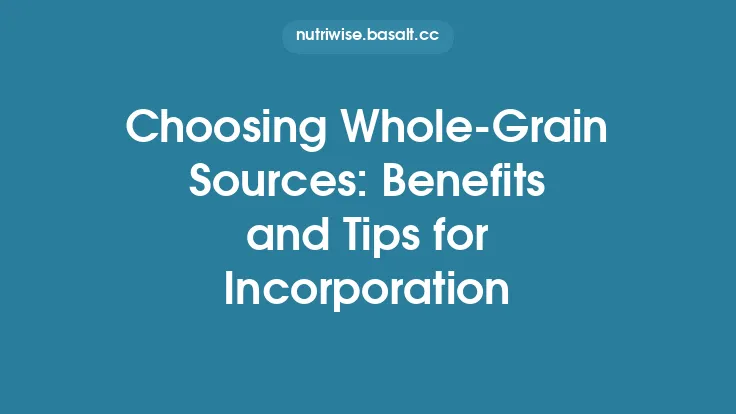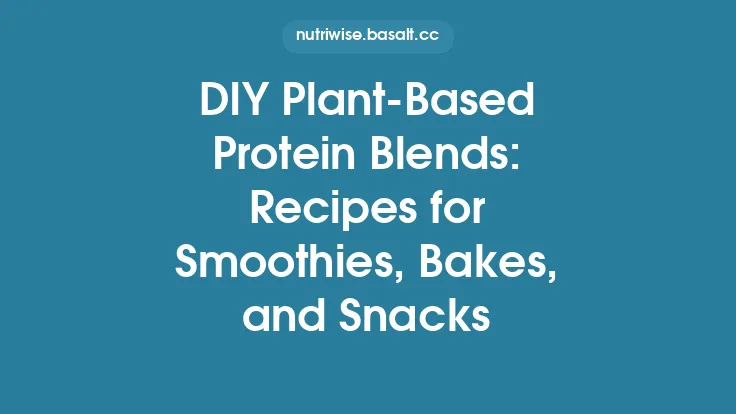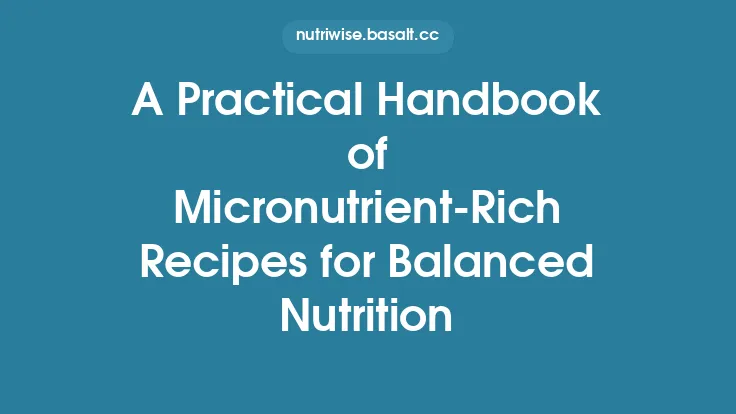Cinnamon has been a staple in kitchens worldwide for centuries, prized not only for its warm, sweet aroma but also for its potential to support healthy blood sugar levels. While the spice’s flavor shines in both sweet and savory dishes, modern research suggests that regular, moderate consumption of cinnamon may help improve insulin sensitivity, slow carbohydrate digestion, and reduce post‑meal glucose spikes. This article explores the science behind cinnamon’s glycemic effects, practical ways to incorporate it into everyday meals, and a collection of delicious, balanced recipes that make the most of this versatile spice.
Understanding How Cinnamon Influences Blood Sugar
Bioactive Compounds
Cinnamon’s health properties stem primarily from a group of polyphenolic compounds known as cinnamaldehyde, cinnamic acid, and cinnamate derivatives. These molecules exhibit antioxidant activity and interact with metabolic pathways that regulate glucose homeostasis.
- Cinnamaldehyde: The compound responsible for cinnamon’s characteristic flavor also modulates insulin receptor signaling, enhancing glucose uptake by muscle and adipose tissue.
- Cinnamic acid: Acts as an inhibitor of intestinal α‑glucosidase, an enzyme that breaks down complex carbohydrates into glucose. By slowing this process, cinnamon can blunt the rapid rise in blood sugar after a carbohydrate‑rich meal.
- Proanthocyanidins: Found in higher concentrations in Ceylon (true) cinnamon, these polyphenols improve insulin receptor function and exhibit anti‑inflammatory effects that protect pancreatic β‑cells.
Types of Cinnamon: Ceylon vs. Cassia
Two main varieties dominate the market:
| Feature | Ceylon (Cinnamomum verum) | Cassia (Cinnamomum cassia) |
|---|---|---|
| Origin | Sri Lanka, Madagascar | China, Indonesia, Vietnam |
| Flavor | Delicate, slightly citrusy | Stronger, sweeter, more pungent |
| Coumarin Content | Very low (<0.004%) | Higher (up to 5%) |
| Recommended Use for Blood Sugar | Safe for daily use, especially for long‑term consumption | Safe in moderate amounts; limit to ≤1 g/day to avoid excess coumarin |
Coumarin, a natural compound present in higher amounts in Cassia, can be hepatotoxic at large doses. For individuals who plan to use cinnamon daily, Ceylon cinnamon is the preferred choice.
Mechanisms of Action
- Enhanced Insulin Sensitivity – Cinnamaldehyde stimulates the insulin receptor’s tyrosine kinase activity, facilitating downstream signaling that promotes glucose transporter (GLUT4) translocation to the cell membrane.
- Reduced Gluconeogenesis – Polyphenols in cinnamon down‑regulate hepatic enzymes (PEPCK, G6Pase) involved in glucose production, thereby lowering fasting glucose.
- Delayed Carbohydrate Absorption – Inhibition of α‑glucosidase and α‑amylase slows the breakdown of starches, leading to a more gradual rise in post‑prandial glucose.
- Anti‑Inflammatory Effects – Chronic low‑grade inflammation impairs insulin signaling. Cinnamon’s anti‑oxidant properties mitigate oxidative stress, supporting healthier insulin action.
Practical Tips for Incorporating Cinnamon Safely
1. Choose the Right Form
- Ground Cinnamon: Most convenient for sprinkling on foods or mixing into liquids. Store in an airtight container away from heat and light to preserve potency.
- Cinnamon Sticks: Ideal for infusing soups, stews, teas, and poached fruits. They release flavor slowly and can be removed before serving.
- Cinnamon Extracts (Water‑Based): Useful for precise dosing in beverages or sauces. Ensure the product is free of added sugars.
- Cinnamon Oil: Highly concentrated; only a few drops are needed. Use sparingly and always dilute in a carrier (e.g., olive oil) before adding to dishes.
2. Dosage Guidelines
- General Daily Intake: 1–2 g (≈½–1 tsp) of Ceylon ground cinnamon, split across meals, is considered safe for most adults.
- For Blood Sugar Support: Studies often use 1.5–6 g per day. Start at the lower end and monitor any changes in blood glucose or liver function (especially if using Cassia).
- Children & Pregnant Individuals: Limit to ≤½ tsp per day of Ceylon cinnamon; consult a healthcare professional before regular use.
3. Pair with Complementary Nutrients
- Protein & Healthy Fats: Combining cinnamon with protein (e.g., Greek yogurt) or monounsaturated fats (e.g., avocado) can further blunt glucose spikes by slowing gastric emptying.
- Fiber‑Rich Foods: Whole grains, legumes, and vegetables add soluble fiber, which works synergistically with cinnamon’s enzyme‑inhibiting effects.
4. Timing Matters
- Pre‑Meal Sprinkle: Adding cinnamon to a small portion of a carbohydrate‑rich dish (e.g., oatmeal) 15–30 minutes before eating can prime the digestive enzymes.
- Post‑Meal Beverage: A warm cinnamon‑infused tea after a meal can aid in stabilizing glucose levels and provide a soothing finish.
5. Storage & Freshness
- Shelf Life: Ground cinnamon retains optimal flavor and bioactivity for 12–18 months. Stale cinnamon loses potency, reducing its glycemic benefits.
- Aroma Test: Fresh cinnamon should emit a sweet, woody scent. If the aroma is faint or musty, replace it.
Recipes That Harness Cinnamon for Glycemic Balance
Below are five balanced recipes—each featuring cinnamon as a star ingredient while emphasizing protein, healthy fats, and fiber to create meals that support steady blood sugar.
1. Cinnamon‑Spiced Overnight Oats
Servings: 1 breakfast
Prep Time: 5 min (plus overnight refrigeration)
Ingredients
- ½ cup rolled oats (whole grain)
- ¾ cup unsweetened almond milk
- ¼ cup plain Greek yogurt (protein boost)
- 1 tsp Ceylon ground cinnamon
- 1 tbsp chia seeds (fiber & omega‑3)
- ½ small apple, diced
- 1 tbsp chopped walnuts
- Pinch of sea salt
Method
- In a mason jar, combine oats, almond milk, yogurt, cinnamon, chia seeds, and salt. Stir until evenly mixed.
- Fold in the diced apple and walnuts.
- Seal the jar and refrigerate overnight (or at least 4 hours).
- In the morning, give it a quick stir. Add a splash of milk if a thinner consistency is desired.
Why It Works: The soluble fiber from oats and chia, paired with protein from yogurt, slows carbohydrate absorption. Cinnamon adds the enzymatic inhibition of α‑glucosidase, helping to moderate the post‑breakfast glucose rise.
2. Savory Cinnamon‑Infused Lentil Soup
Servings: 4 bowls
Prep Time: 15 min | Cook Time: 35 min
Ingredients
- 1 tbsp extra‑virgin olive oil
- 1 medium onion, finely chopped
- 2 garlic cloves, minced (optional for flavor, not a focus)
- 1 tsp ground cumin
- ½ tsp Ceylon ground cinnamon
- 1 cup dried brown or green lentils, rinsed
- 4 cups low‑sodium vegetable broth
- 1 cup diced tomatoes (canned, no added sugar)
- 2 carrots, diced
- 2 celery stalks, diced
- 1 bay leaf
- Salt & pepper to taste
- Fresh cilantro or parsley for garnish
Method
- Heat olive oil in a large pot over medium heat. Add onion and sauté until translucent, about 4 minutes.
- Stir in cumin and cinnamon; cook for 30 seconds to release aromatics.
- Add lentils, broth, tomatoes, carrots, celery, and bay leaf. Bring to a boil, then reduce to a simmer.
- Cover and cook for 25–30 minutes, or until lentils are tender.
- Remove bay leaf, season with salt and pepper, and blend partially for a creamy texture if desired.
- Garnish with chopped cilantro or parsley before serving.
Why It Works: Lentils provide plant‑based protein and resistant starch, both of which blunt glucose spikes. The modest amount of cinnamon enhances insulin sensitivity without overwhelming the savory profile.
3. Cinnamon‑Almond Butter Smoothie
Servings: 1 snack or post‑workout drink
Prep Time: 5 min
Ingredients
- 1 cup unsweetened soy or oat milk
- 2 tbsp almond butter (healthy fats & protein)
- ½ frozen banana (optional for natural sweetness)
- 1 tsp Ceylon ground cinnamon
- 1 tbsp ground flaxseed (fiber)
- ¼ tsp vanilla extract
- Ice cubes (optional, for thickness)
Method
- Add all ingredients to a high‑speed blender.
- Blend until smooth, adjusting thickness with extra milk or ice as needed.
- Pour into a glass and enjoy immediately.
Why It Works: The combination of protein (almond butter), healthy fats, and fiber (flaxseed) creates a low glycemic load. Cinnamon’s insulin‑sensitizing effect further supports stable glucose levels after the snack.
4. Cinnamon‑Glazed Roasted Sweet Potatoes
Servings: 4 side portions
Prep Time: 10 min | Cook Time: 30 min
Ingredients
- 2 large sweet potatoes, peeled and cut into 1‑inch cubes
- 2 tbsp melted coconut oil
- 1 tsp Ceylon ground cinnamon
- ½ tsp smoked paprika (optional for depth)
- ½ tsp sea salt
- Freshly ground black pepper (optional, not a focus)
- 1 tbsp chopped pecans (for garnish)
Method
- Preheat oven to 200 °C (400 °F). Line a baking sheet with parchment paper.
- In a large bowl, toss sweet potato cubes with coconut oil, cinnamon, smoked paprika, salt, and pepper until evenly coated.
- Spread the cubes in a single layer on the prepared sheet.
- Roast for 25–30 minutes, turning halfway through, until golden and tender.
- Sprinkle with chopped pecans before serving.
Why It Works: Sweet potatoes have a moderate glycemic index, but the fiber and resistant starch content help moderate glucose absorption. The cinnamon glaze adds a sweet‑spicy note while contributing its glucose‑modulating properties.
5. Cinnamon‑Infused Chia Pudding with Berries
Servings: 2 desserts or breakfast bowls
Prep Time: 5 min (plus 4 hours refrigeration)
Ingredients
- ½ cup chia seeds
- 1 ½ cups unsweetened coconut or almond milk
- 1 tsp Ceylon ground cinnamon
- 1 tbsp maple syrup or a low‑glycemic sweetener (optional)
- 1 tsp vanilla extract
- ½ cup mixed fresh berries (blueberries, raspberries, strawberries)
- 1 tbsp toasted pumpkin seeds (optional garnish)
Method
- In a mixing bowl, whisk together milk, cinnamon, sweetener (if using), and vanilla.
- Stir in chia seeds until fully incorporated.
- Cover and refrigerate for at least 4 hours, or overnight, allowing the mixture to thicken.
- Divide the pudding into two bowls, top with fresh berries and pumpkin seeds.
- Serve chilled.
Why It Works: Chia seeds are rich in soluble fiber that forms a gel in the stomach, slowing carbohydrate digestion. Cinnamon adds an extra layer of glucose regulation, while berries provide antioxidants without a high sugar load.
Integrating Cinnamon Into Everyday Meal Planning
- Breakfast Rotation: Alternate between oatmeal, smoothies, and chia pudding to keep the palate fresh while maintaining a consistent cinnamon intake.
- Lunch Boost: Sprinkle a pinch of cinnamon onto grain bowls (e.g., quinoa with roasted vegetables) or mix into a vinaigrette for a subtle sweet note.
- Dinner Enhancements: Use cinnamon sticks to infuse braised meats, stews, or roasted root vegetables. Remove before serving to avoid overpowering the dish.
- Snack Smart: Pair a small handful of nuts with a dusting of cinnamon, or enjoy a cinnamon‑spiced apple slice with nut butter.
- Beverage Options: Brew a warm cinnamon tea (steep 1–2 sticks in hot water for 5 minutes) or add a dash of cinnamon to coffee or hot chocolate for a healthful twist.
Monitoring Effects and Safety Considerations
- Blood Glucose Tracking: Individuals with diabetes or pre‑diabetes should monitor fasting and post‑prandial glucose levels when introducing regular cinnamon consumption. A modest reduction (5–10 %) in post‑meal spikes is commonly reported in studies.
- Liver Health: If using Cassia cinnamon, keep total daily intake below 1 g to stay within safe coumarin limits. Periodic liver function tests are advisable for long‑term high‑dose users.
- Allergies & Sensitivities: Though rare, some people may experience skin irritation or gastrointestinal discomfort from high cinnamon doses. Reduce the amount or switch to Ceylon cinnamon if symptoms arise.
- Medication Interactions: Cinnamon may potentiate the effect of oral hypoglycemic agents (e.g., metformin, sulfonylureas). Consult a healthcare professional before combining high‑dose cinnamon with such medications to avoid hypoglycemia.
Summary of Key Takeaways
- Cinnamon’s active polyphenols (cinnamaldehyde, cinnamic acid, proanthocyanidins) support insulin sensitivity, inhibit carbohydrate‑digesting enzymes, and reduce hepatic glucose production.
- Ceylon cinnamon is the preferred variety for daily use due to its low coumarin content.
- Effective dosage for blood‑sugar support ranges from ½ to 1 tsp (≈1–2 g) of ground Ceylon cinnamon per day, split across meals.
- Pairing cinnamon with protein, healthy fats, and fiber maximizes its glycemic benefits.
- Practical applications include breakfast oats, savory soups, smoothies, roasted vegetables, and chia puddings—each designed to deliver balanced nutrition while leveraging cinnamon’s glucose‑modulating properties.
- Safety hinges on moderate consumption, choosing Ceylon cinnamon for long‑term use, and monitoring any interactions with diabetes medications.
By thoughtfully incorporating cinnamon into a varied, nutrient‑dense diet, you can enjoy its comforting flavor while harnessing its potential to help maintain stable blood sugar levels—an evergreen strategy for long‑term metabolic health.





